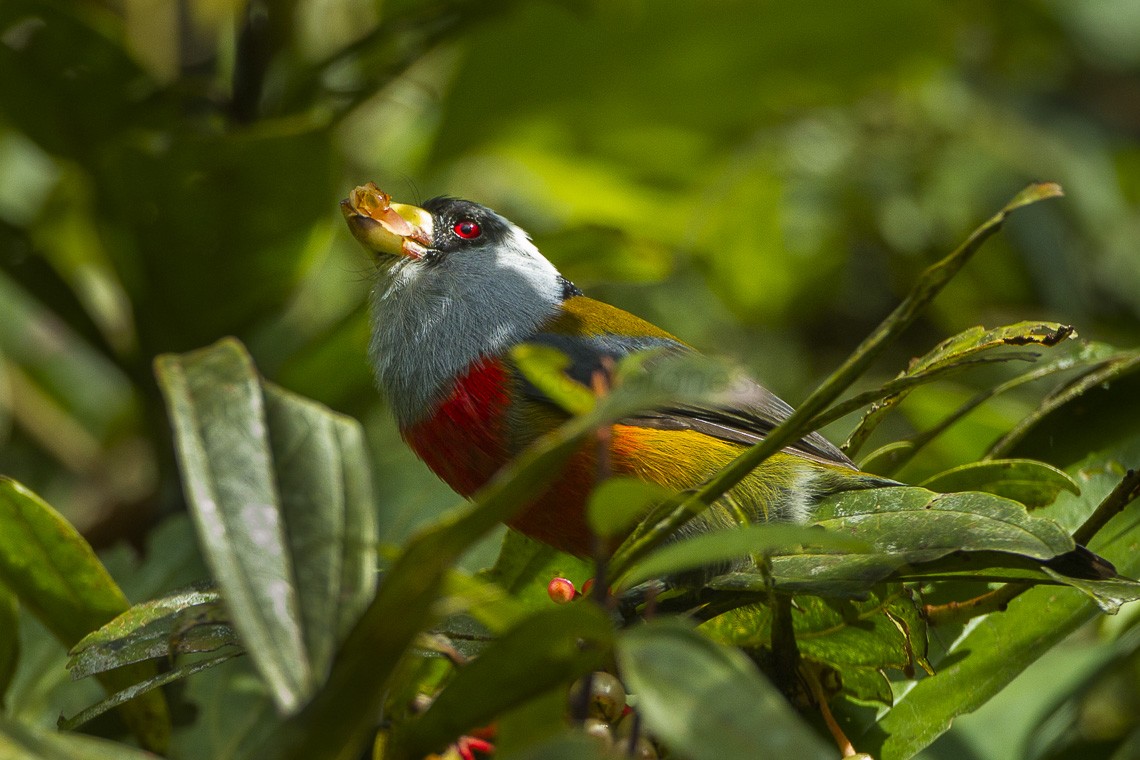Toucan Barbet
A species of Prong-billed Barbets Scientific name : Semnornis ramphastinus Genus : Prong-billed Barbets
Toucan Barbet, A species of Prong-billed Barbets
Botanical name: Semnornis ramphastinus
Genus: Prong-billed Barbets
Content
Description General Info
 Photo By Francesco Veronesi , used under CC-BY-SA-2.0 /Cropped and compressed from original
Photo By Francesco Veronesi , used under CC-BY-SA-2.0 /Cropped and compressed from original Description
The toucan barbet is a medium-sized robust barbet, of 19 to 21 cm (7.5–8.3 in) long and weighing 80–115 g (2.8–4.1 oz). The beak is robust with a yellow maxilla and a light green mandible, both with dark ends. It is pronged at the end, though the prongs are not noticeable in the field. The plumage is colourful and includes a black crown, "mask", and thin cervical collar. The species has long occipital feathers and a conspicuous white stripe behind the eyes, which has a bright red-colored iris. The nape of the neck is golden-brown and becomes yellow towards the rump. The throat, upper breast, and sides of the nape are grayish-blue. The lower breast and middle belly are bright red, while the lower belly is yellowish green. The wings and tail are grey. The subspecies S. r. caucae is very similar to the nominate race, but has less extensive red on the breast. Both sexes are almost identical except for the female's plumage being slightly less bright, and the female lacks the tuft on the black plumage of the nape. Immature birds are duller than adults, and do not develop prongs until they are 4 months old. 
Size
21 cm
Nest Placement
Cavity
Feeding Habits
Toucan Barbet is primarily frugivorous, consuming 62 species of fruits, with Cecropia and Clusia being significant. Toucan Barbet also eats insects, small reptiles, nectar, tree sap, and flower petals, varying seasonally. Nestlings have an insect-rich diet. Toucan Barbet forages from ground level to canopy for 12 hours daily, occasionally in mixed-species groups.
Habitat
Toucan Barbet thrives in humid premontane to montane evergreen forests in the western Andes, favoring altitudes of 1,400 to 2,400 meters. Preferring the upper canopy and subcanopy, they are adaptable to secondary forests and edge habitats but require specific nesting sites in old Lauraceae trees. Habitat loss due to deforestation is a major threat to their existence.
Dite type
Frugivorous
General Info
Feeding Habits
Bird food type

Fruit
Behavior
The toucan barbet is usually found in pairs or small groups perched silently on long horizontal branches, making them hard to find unless active or singing. The flight is characterized by being hurried and noisy. It usually lives in small groups of three to six individuals. The species is territorial, with territories ranging between 4–10.6 ha (9.9–26.2 acres), with an average of 5.8 ha (14 acres). Most of the territory consists of mature forest, although the species can adapt to live in forests with small areas of secondary forest or pastures. Toucan barbet groups show a marked territorial behavior towards other groups or species, which is usually made clear by the loud duets of breeding pairs, and it is actively protected by the breeding pair by chasing of intruders. The family group's helpers assist in this, especially near the nest. In the absence of interference, these groups can occupy a particular territory for a year or longer. 
Distribution Area
The species is native to the humid forests of the western Andes, from the Andean slopes of northwest Ecuador to southwest Colombia, at altitudes of 1,400–2,400 m (4,600–7,900 ft). It uses all forest strata, showing some preference for the upper canopy of the forest (11–20 m (36–66 ft)) and the subcanopy (6–10 m (20–33 ft)). The species also uses secondary forest and forest-edge habitats. Evidence suggests that these birds are very specific in choosing trees for nesting. It usually prefers old trees in the family Lauraceae. As nesting trees of sufficient diameter are not very common in these forests, habitat loss through logging is impacting the species. 
Species Status
The species is classified as near threatened by the IUCN. Though still fairly common locally, its populations have decreased due to habitat loss, accelerated by massive logging operations, deforestation, cattle grazing, and mining. Illegal trapping for the local and international cage-bird trade is considered to be the main threat to this species, as it is adaptable and can tolerate some habitat modification if left unmolested. Heavy trapping pressure and habitat fragmentation due to forest clearing are thought to be responsible for some localised extinctions of this species. 